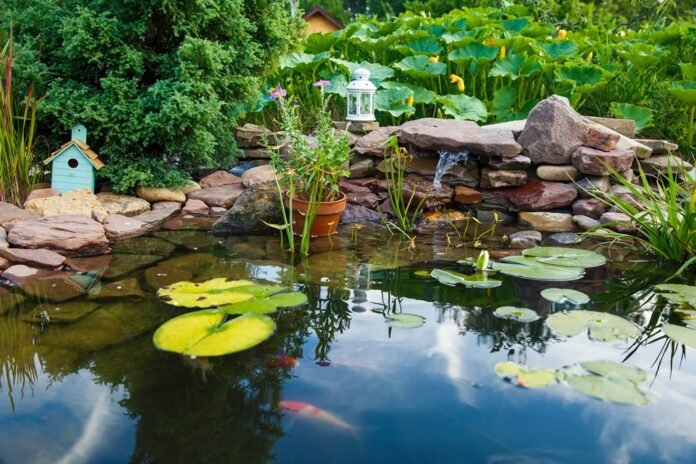Preserving the clarity and beauty of your pond for as long as possible requires regular upkeep. Just a little bit of research into the water chemistry of your pond and the usage of natural pond care solutions in place of harmful algaecides and pricey UV sterilizers will get you one step closer to the pond of your dreams.
By following our expert guidelines, you can make sure that the quality of the water in your pond improves and stays high. You can keep your pond in pristine condition through the end of any season by following these simple tips.
1. Boost O2 Levels
Without a doubt, your pond will need more oxygen in the summer, as warm water naturally stores less oxygen than cool water. If you want a healthy pond, you shouldn’t wait until you notice a problem before taking action to improve oxygen levels.
To begin, plant oxygen-producing plants in your pond for aesthetic purposes. Floating plants such as water hyacinth and lettuce not only provide oxygen to the water, but also provide shade to reduce the water’s temperature and prevent the growth of algae. Water plants such as hornwort and arrowhead are also great options.
However, vegetation alone isn’t sufficient. Good aeration is also required to maintain water movement and oxygen circulation. Thankfully, aeration can also be aesthetically pleasing. One of the best and most visually appealing methods to keep water moving is with a fountain or cascade.
Electronic aerators can also be added and are normally small, silent, and simple to set up.
By employing one or more of these methods of aeration and circulation, oxygen levels in the water can be maintained at a consistent level. And since mosquitoes breed in stagnant water, aeration will help eliminate that breeding ground.
2. Rearrange Fish Meals
It’s tempting to give your fish a little extra food now that they’re awake and swimming about more than usual. The remaining food will quickly decompose in warm water, sucking up valuable oxygen and generating toxic gases, making this the worst time of year to overfeed.
Regularly feeding fish is an excellent idea year-round. They will rapidly adjust to your routine and be ready to eat whenever you get there.
If you want them to eat, give them only what they can finish in five minutes. To do so increases the likelihood that some of the food will spoil.
3. Conduct The Pruning Process
Your garden plants receive occasional trimming from you. Similarly, water plants thrive when you do this. They continue to flourish in a balanced pond, but too many of them or ones that are too large a nuisance to the ecosystem should be avoided. This is why annual fall trimming is done.
Submerged oxygen-producing plants are included in this category, although surface-dwelling marsh plants and other species are also included. Parts of the water lily, for instance, perish at the end of each growing season.
Dead leaves and blooms in a pond should be removed as soon as possible to prevent them from decaying to the bottom.
4. Revitalize Your Plants
Now that summer’s flowers have faded, fall is a fantastic time to introduce new plants to your pond. In addition to enhancing the landscape’s aesthetic value, late-summer plantings play a crucial role in keeping the area free of unsightly algae.
Shading your pond from the hot August heat may greatly reduce the likelihood of an algal bloom.
Adding attractive and useful plants like water lettuce, lilies, and hyacinth to your pond in the summer may do wonders for its aesthetics and ecological health. You can also add some led strip wholesale lights along the pond border. It will increase the beauty of these flowers and plants tremendously.
5. Correct Water Values
If you give your pond what it needs, measuring water parameters isn’t necessary. Our preference is for water to be naturally clear, without any added chemicals.
Also, never underestimate the importance of using a pond filtration system to have balanced and clean water all around the year. This will keep chemical utilization at bay too.
6. Look At The Fish’s Actions
Temperatures rise sharply during the end of summer, which may affect the ecosystem of your pond. Fish can grow ill in warmer water since it doesn’t hold as much oxygen as cooler water.
In addition, the usage of algaecides to prevent these unsightly green blooms can lead to the decomposition of organic materials, which in turn consumes even more oxygen, so reducing the available supply.
Observing the fish in your pond might be a good indicator of how well-oxygenated it is. They are not getting enough oxygen from the water if you see them breathing rapidly or, even worse, coming to the surface to breathe.
7. Suppress The Predators
It’s important to keep fish safe all summer long because predators don’t take the summer off, but late summer and early fall can be particularly dangerous.
Fall’s cooling temperatures cause fish to slow down, making them easy targets for herons and other predators.
Before you lose all your koi in one swoop, install a deterrent immediately, even if you haven’t had any problems with them so far.
Conclusion
This pond is at its best in July, when the water lilies are in full bloom, the fish are thriving, the frogs are lounging in the water, and the birds drop by for a drink or a quick swim. At this time, you will just love to hang out with your partner or kids alongside this beautiful view.
Always make sure to use secure strollers by a reputable stroller manufacturer if you have young kids. Letting them roam around freely near the pond is a bad idea.
You, the lucky owner of a pond, can enjoy the best feeling ever!
















